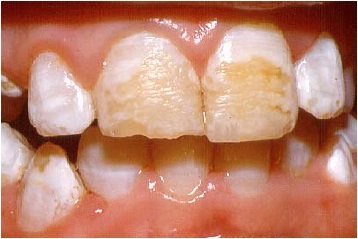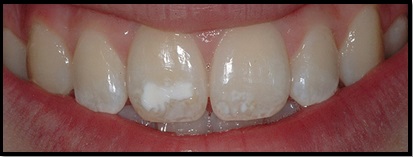Dr. Hall,
What is the best way to treat hypoplasia (to make the teeth look
more uniform in color)? Is composite bonding the best option?
– Jennifer from North Carolina
(See Dr. Hall’s answer below.)
We thank our advertisers who help fund this site.
Jennifer,
There are a variety of ways to treat enamel hypoplasia, depending on how severe the hypoplasia is.
Enamel hypoplasia is a defect in which the enamel of the teeth hasn’t fully formed. This can be because of a genetic defect, or can be caused by disease during the formation of the teeth. (Most tooth formation occurs from before birth through about twelve years of age.) Severe hypoplasia results in enamel that is thin, often pitted, and there may be places where the dentin shows in spots, giving the tooth a spotted appearance. Mild hypoplasia can involve just mild white spots on the teeth.
Here is a photo of  severe enamel hypoplasia. These front teeth show characteristic horizontal striations in the enamel, which is thin and may be completely missing in some places. These teeth have turned brownish. Adjoining teeth have been affected less, with white spots and some pitting.
severe enamel hypoplasia. These front teeth show characteristic horizontal striations in the enamel, which is thin and may be completely missing in some places. These teeth have turned brownish. Adjoining teeth have been affected less, with white spots and some pitting.
Proper treatment of enamel hypoplasia this severe will require porcelain veneers over the teeth affected. If the linguals (inside surfaces) of any teeth are severely affected like we see on the front two teeth, it may even require full crowns on those teeth.
Then, at the other extreme, here is a case of mild hypoplasia affecting just one central incisor. 
For this, I would recommend direct composite bonding of the one central incisor. The dentist would drill out the very surface of the white spot and replace it with a high-gloss composite. The tiny spots on the other central could either be left alone or treated with little spots of composite, depending on whether or not the patient was self-conscious of the spots.
For either of these cases, I would recommend going to an expert cosmetic dentist. Even for the bonding on the one tooth, most general family dentists are going to tend to stock general-purpose composites and they won’t have the high-gloss, translucent composites that would be required to do a beautiful job.
– Dr. Hall
Do you have a comment or anything else to add? We’d love to hear from you. Enter your comment below. Or click here to ask Dr. Hall a question.
About David A. Hall
Dr. David A. Hall was one of the first 40 accredited cosmetic dentists in the world. He practiced cosmetic dentistry in Iowa, and in 1990 earned his accreditation with the American Academy of Cosmetic Dentistry. He is now president of Infinity Dental Web, a company in Mesa, Arizona that does advanced internet marketing for dentists.
